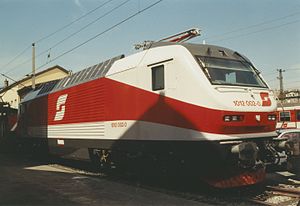ÖBB 1012
| ÖBB series 1012 | |
|---|---|
| Numbering: | 1012 001-003 |
| Number: | 3 |
| Manufacturer: | SGP Graz , Siemens , ELIN , ABB |
| Year of construction (s): | 1996 / acceptance 1997 |
| Retirement: | 2006 - sold to Sweden in 2007 |
| Axis formula : | Bo'Bo ' |
| Length over buffers: | 19300 mm |
| Bogie axle base: | 2,800 mm |
| Service mass: | 82.6 t |
| Top speed: | 160 (230) km / h |
| Continuous output : | 6,400 kW |
| Starting tractive effort: | 280 kN |
| Performance indicator: | 77.5 kW / t |
| Power system : | 15 kV / 16.7 Hz |
| Number of traction motors: | 4 × engine 6FIA 7062 |
| Drive: | IGA drive |
| Brake: | Net brake 150 kN; Air brake |
| Train control : | LZB 80 and Indusi 80 |
The 1012 series of the Austrian Federal Railways is a four-axle electric locomotive with three-phase drive , only three of which were built in 1996. They were to serve as prototypes for the successor series of the 1044 series . After the Taurus was brought forward for series procurement , the locomotives were a splinter class and were sold to the Swedish railway company Hector Rail in 2007 .
prehistory
The locomotive was to be the successor to the 1044 series . It had to be designed for the transport from 660 t to 5 ‰ at 220 km / h and 600 t to 28 ‰ at 100 km / h. The specification called for a locomotive that can be used both in front of fast passenger trains in the lowlands and in double traction in front of heavy freight trains in the mountains. It was very similar to that of the SBB Lok 2000 .
The mechanical part comes from Simmering-Graz-Pauker , the electrical equipment from Siemens , ELIN and ABB . The suppliers organized themselves in ARGE 1012 with Siemens as leader.
construction
mechanical construction
The bogies are similar to the 1014 series , but like the DB BR 101 have the integrated overall drive from ABB .
The structure of the box is based heavily on the SBB locomotive 2000 . The side walls made of corrugated sheet steel form a U-shaped construction with the floor frame. The aluminum roofs also contain the calming space for the cooling air.
For weight reasons, the front modules for the driver's cab are made of glass fiber reinforced plastic (GRP) and glued to the box. The construction consists of two GRP panels with a tough, elastic foam core in between. A steel ram protection installed behind the driver's desk protects the driver in the event of a collision.
Electric Construction
The oil-cooled transformer from ELIN is suspended under the locomotive body and has six traction windings. Two water-cooled GTO converters from Siemens supply the bogies with energy, with each drive motor being supplied by its own inverter.
The control technology of the locomotive is from Siemens . The locomotive is equipped with LZB and Indusi 80 .
design
The locomotive was designed by the then chief designer of ÖBB, Wolfgang Valousek, who himself describes it as his best work.
Use and whereabouts
When the three prototypes of the 1012 series were already being built, on the one hand the EU tendering mode was changed, on the other hand a new ÖBB board took office. The ÖBB did not want to take over the locomotives for the time being - especially at the requested price of 6.4 million EUR each. The delivery finally took place in 1997, with each locomotive costing only around EUR 5 million.
Before the prototypes were delivered, the ÖBB had already decided on the somewhat more powerful and, above all, cheaper Taurus . As a result, she decided not to buy measuring axles for the 1012 , so that the locomotives could never be approved for the planned top speed of 230 km / h.
The locomotives ran in the Innsbruck area and hauled trains on the Rolling Landstrasse until they were shut down in 2006. The Swedish company Hector Rail first tested the 1012.002 in 2005 and 2006 before purchasing all three locomotives in March 2007. These now have the company numbers 141.001 to 003, have a dark gray / orange paint and are based in Hallsberg .
literature
- Markus Inderst : Picture atlas of the ÖBB locomotives. All traction vehicles of the Austrian Federal Railways. GeraMond, Munich 2010, ISBN 978-3-7654-7084-4 .
Web links
- Pictures of the series 1012
- Pictures of the ÖBB 1012 on schienenfahrzeuge.netshadow.at. Retrieved September 28, 2016 .
Individual evidence
- ↑ Interview with Wolfgang Valousek , Bahnorama 2008

